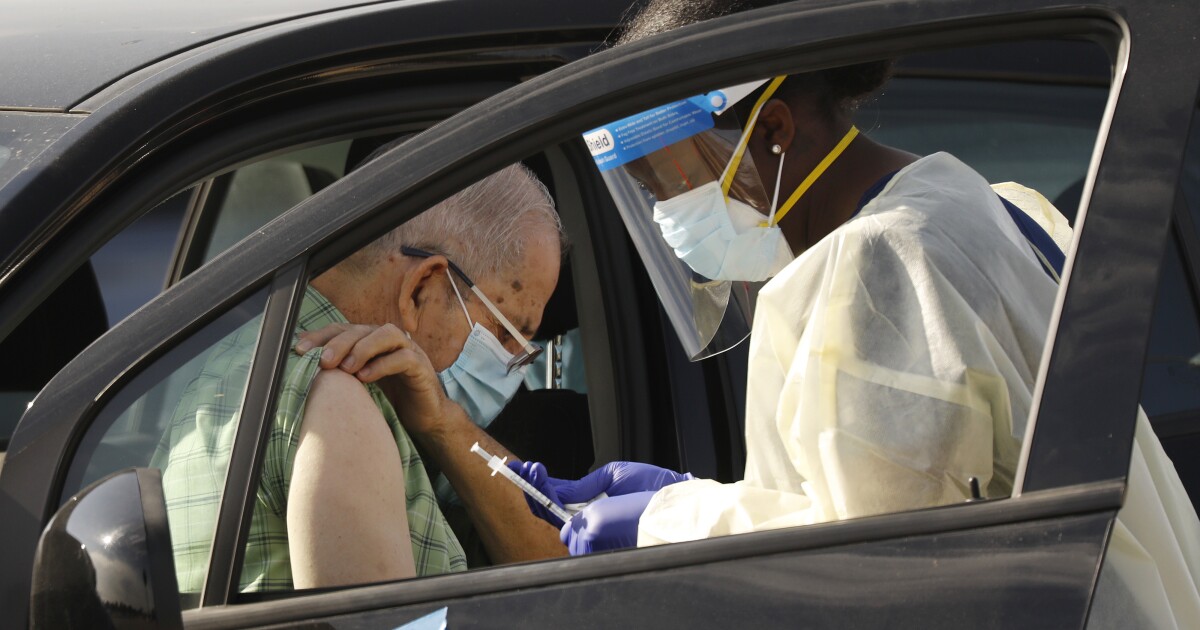Vaccination of Californians aged 65 and over could take until June to complete, the state epidemiologist said on Wednesday, raising new concerns about when other groups will be eligible for the vaccine and highlighting rapidly growing stocks of COVID-19 vaccine. reduction.
This schedule would delay access to the vaccine for people who are not currently on the priority list for at least four months, based on the estimate of state epidemiologist Dr. Erica Pan at a vaccine advisory committee meeting. The current list of priorities, in addition to older residents, includes healthcare workers and employees and residents of nursing homes.
The current pace could change if the federal government accelerates shipments beyond the current rate of 300,000 to 500,000 doses per week, Pan said. To date, the state has received about 4 million doses of vaccine from the federal government.
“We don’t know when the supply will be increasing,” said Pan during a vaccine advisory committee on Wednesday, noting that the state is not holding the vaccine. The assessment is based on dosage levels for the Pfizer-BioNtech and Moderna vaccines, which require two doses for effectiveness. If the allocation increases and distribution accelerates, or a new single-dose vaccine is approved, the schedule may change, she said.
In Los Angeles County, the picture was also hampered by deficiencies. The county needs more than 4 million doses to provide the two-dose vaccine protocol to all health professionals – an estimated 800,000 people – along with 1.3 million residents aged 65 and over, officials said.
But, so far, the municipality has received only 853,650 doses. As soon as the 2.2 million residents on the current priority list are vaccinated, there will be another 8 million left – each of whom would need two doses of the current vaccines.
Next week, the county will receive 143,900 doses, but 106,000 of those doses, more than 70%, will be used in second doses for healthcare professionals and others. This will leave only 37,900 for the elderly and unvaccinated health professionals, according to authorities’ estimates.
“Our ability to protect even more LA County residents in the coming weeks and months is totally dependent and limited by the amount of vaccine we receive each week, and we often do not know from one week to the next how many doses will be allocated to the LA County, ”said public health director Barbara Ferrer at a news conference on Wednesday.
Ferrer said the county does have a robust network of more than 200 health care providers, including hospitals, health plans and pharmacies, ready to vaccinate the public. “We have a lot of potential in the system to actually be able to deliver a lot of vaccines, but we don’t have a lot of vaccines to deliver,” said Ferrer.
And in the short term, public authorities in LA County said they did not expect the amount of vaccine the state receives and allocates to the county to increase dramatically.
Dr. Seira Kurian, director of the Medical Affairs Division of the LA County Department of Health, said in a town hall on Tuesday night that officials thought the federal government had vaccine reserves that would be handed over to counties to increase supply when municipalities began to administer second doses.
“But as it is not clear how much, if any, of these reserves are available, what is likely to happen is that we are unlikely to see a huge increase in the number of doses that enter us every week, but we are hoping that we will still be receiving the doses of vaccine at the current rate and current levels, ”at least in the short term, said Kurian.
Counties across the state continued to report dwindling supplies. Fresno County officials planned to vaccinate 30,000 a week, but were forced to reduce that number to 8,000 to 10,000 a week, said Joe Prado, manager of the county’s community health division, on Tuesday.
The county asked the state for an additional 20,000 doses, but was told it would receive 5,100. “We will run out of vaccine if our allocation does not increase,” said Fresno County interim health officer, Dr. Rais Vohra.
A similar situation is taking place in San Francisco, where city officials warned on Tuesday that vaccine availability would end on Thursday because the city’s vaccine distribution dropped significantly from the previous week and the doses that had to be discarded have not been replaced.
Dr. Grant Colfax, San Francisco’s director of public health, said at a news conference that the city received 12,000 doses a week ago and asked for the same number this week. Instead, the city received only 1,775 doses.
Pan, the state epidemiologist, said more doses will be available after the state releases a large batch of Moderna’s COVID-19 vaccine. The state told health professionals on Sunday to temporarily stop using the specific batch of 330,000 doses after a “greater than normal” number of allergic reactions was reported.
Pan said the state is “likely to be able to release this pause” after a review by the Scientific Safety Review Working Group, along with input from allergists and the Centers for Disease Control and Prevention and that an announcement about the decision is pending. The apparent allergic reactions occurred at a clinic in San Diego.
“The important thing that happened in this situation is that the right protocols were in place and all individuals are at home and well,” said Pan.
Times staff writer Maura Dolan contributed to this report.
